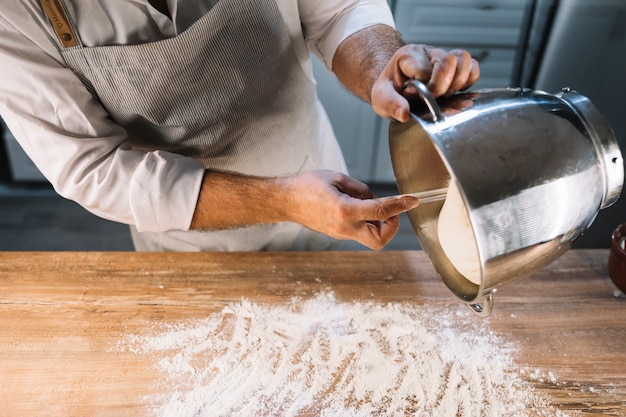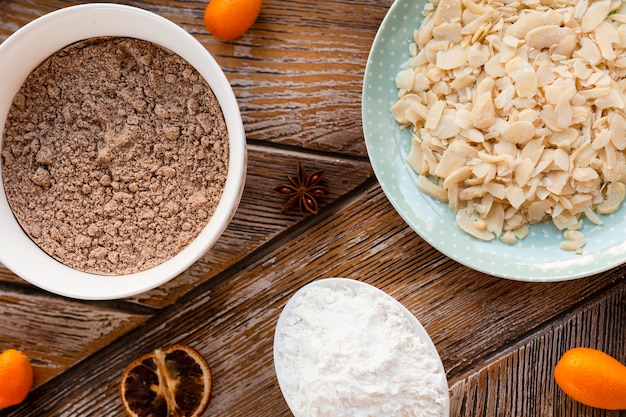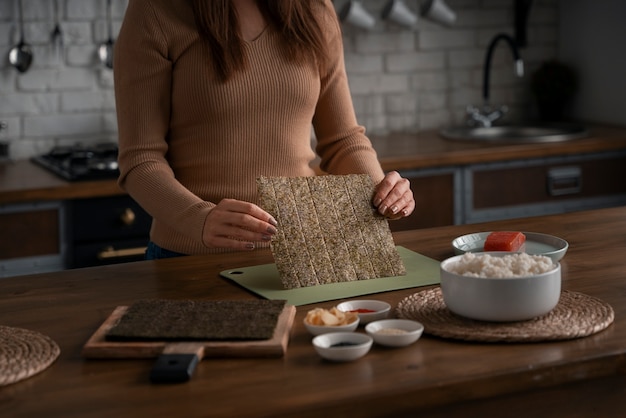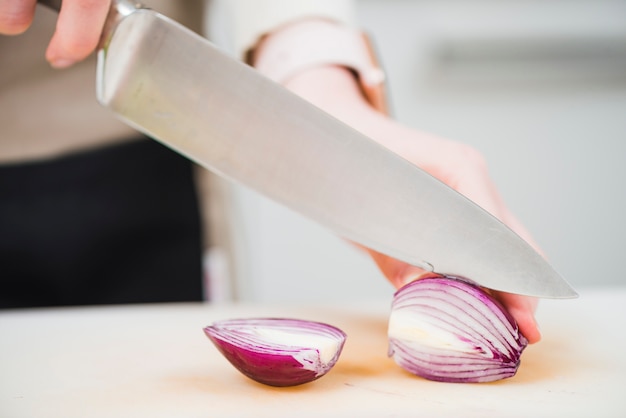(Part 1) The Rice Cooker: A Kitchen Game Changer

For years, I relied on the tried-and-true saucepan method. I’d diligently measure the rice, water, and even throw in a pinch of salt. But the truth is, it was a bit of a gamble. There was always that nagging feeling of uncertainty – "Did I use the right water ratio?" "Is it going to be undercooked or mushy?"
Then came the rice cooker, my kitchen savior. And let me tell you, it completely transformed my rice-making experience. No more guessing games. No more worrying about the rice sticking to the bottom of the pot. It's a foolproof method that consistently delivers perfect brown rice.
Why the Rice Cooker Reigns Supreme
The rice cooker is a kitchen superhero, and here's why:
- Perfect Water Ratio: The rice cooker takes all the guesswork out of the water ratio. You can finally kiss goodbye to those days of overcooked or undercooked rice. Just follow the instructions on your rice cooker, and you're golden. It’s like having a personal rice chef in your kitchen!
- Set It and Forget It: The rice cooker is a master of hands-free cooking. Just throw in the rice and water, press a button, and you're done! You can go about your day, and by the time you’re ready to eat, your perfectly cooked rice will be waiting for you. It's that simple.
- Minimal Cleanup: After the cooking is done, the only thing you need to clean is the rice cooker pot – a breeze compared to the saucepan method.
(Part 2) choosing the right rice: The Foundation of Flavor

Now, let’s talk about the star of the show: the rice itself. You’ve got the rice cooker, but what kind of rice should you use? The choice of rice is essential for achieving that perfect texture and flavor.
The Importance of Freshness
For the most delicious results, always start with fresh rice. Check the "best by" date and make sure the rice is not stale. Trust me, stale rice can make a noticeable difference in the final product. You’ll find the texture is less enjoyable, and the flavor isn't as vibrant.
long grain brown rice: My Go-To Choice
When it comes to brown rice, I'm a big fan of long grain. It has a satisfying chewiness that I find really enjoyable. It also holds up well in salads and stir-fries, making it a versatile choice. But don't be afraid to experiment with other varieties. You might find a hidden gem!
(Part 3) The Perfect Ratio: Unveiling the Secret to Success

The key to perfect brown rice? It's all about the water ratio. Get this ratio right, and you'll be rewarded with fluffy, tender rice that melts in your mouth. Get it wrong, and you might end up with something a bit too mushy or dry.
My Tried-and-True Method
My preferred ratio for long grain brown rice is 1:1.5. For every cup of rice, I use 1.5 cups of water. This ratio works wonderfully for me, but your rice cooker might have its own recommendations. Always refer to your user manual for the best guidance.
Experimentation: Finding Your Personal Sweet Spot
Don’t be afraid to experiment! Maybe you prefer a slightly softer texture or a bit more chewiness. Just remember to adjust the water ratio accordingly and keep track of what works best for you. Every cook has their own unique preference!
(Part 4) Pre-Soaking: A Simple Trick for Better Results
This step is optional, but I highly recommend it. Pre-soaking your brown rice can make a noticeable difference in the texture and cooking time. It helps the rice cook more evenly and can even reduce the overall cooking time.
Pre-Soaking 101
It’s incredibly simple: Just combine your rice with cold water in a bowl, making sure the water level is about 2 inches above the rice. Let it sit for at least 30 minutes, or even better, overnight. Once it's soaked, drain the water and rinse the rice thoroughly.
The Benefits of Soaking
Pre-soaking has a few benefits:
- Faster Cooking: You can shave off about 15-20 minutes from your cooking time.
- Improved Texture: The rice cooks more evenly, resulting in a smoother texture.
- Enhanced Nutrient Absorption: Soaking helps to reduce phytic acid, which can interfere with nutrient absorption.
Ultimately, pre-soaking is a matter of personal preference. Try it out and see if you notice a difference in your rice.
(Part 5) The Cooking Process: A Symphony of Simplicity
Okay, let's get to the fun part - the cooking process! With a rice cooker, it's incredibly easy. You can probably do it with your eyes closed.
Step-by-Step Guide
- Measure and Combine: Measure your rice and water according to your chosen ratio.
- Pour into the Rice Cooker: Pour the rice and water into your rice cooker.
- Stir it Up: Give the rice a good stir to ensure it's evenly distributed.
- Close and Cook: Close the lid of the rice cooker and press the "Cook" button.
- Relax and Enjoy: Sit back, relax, and let the rice cooker do its magic. No need to babysit the pot!
The "Keep Warm" Function: A Culinary Time Saver
Once the cooking cycle is complete, your rice cooker will automatically switch to the "Keep Warm" mode. This is a lifesaver if you’re not ready to eat right away. Your rice will stay warm and delicious for a few hours, so you can take your time without worrying about it getting cold.
(Part 6) The Art of Fluffing: Achieving that Perfect Texture
Okay, so the rice is cooked, and it smells heavenly. But there’s one more important step to ensure that perfect fluffy texture we all crave: fluffing.
Fluffing the Rice: A Gentle Touch
Once the rice cooker has finished cooking, gently open the lid. Using a fork or a rice paddle, carefully fluff the rice. Gently separate the grains and allow some of the steam to escape. This helps create that light, airy texture.
A Word of Caution
Be careful not to over-fluff! You want to separate the grains, but not break them up too much. A gentle hand will ensure that fluffy texture you desire.
(Part 7) Enhancing the Flavor: A Pinch of Salt at the Right Time
This is a topic of much debate among rice enthusiasts. Some people swear by adding salt to the rice water before cooking. However, my personal preference is to add a pinch of salt after the rice is cooked.
Why I Prefer Post-Cooking Salt
I find that adding salt at the end allows me to control the saltiness to my liking. It also gives me the opportunity to add other seasonings, like garlic powder or herbs, to create a more complex flavor profile. Ultimately, it’s all about personal preference!
(Part 8) Storing and Reheating: Keeping Your Rice Fresh
So, you’ve got a pot of perfect brown rice, and now you’re thinking about how to make it last.
Storing Cooked Rice: A Guide to Freshness
To keep your cooked rice fresh, transfer it to an airtight container and refrigerate it. It will stay fresh for about 3-4 days.
Reheating Rice: Keeping the Flavor Intact
When you’re ready to enjoy your rice, reheat it in the microwave or on the stovetop. Add a tablespoon or two of water to the container or pan and heat until warm.
Making the Most of Leftovers: A Culinary Canvas
Don't let those leftovers go to waste! Brown rice is a fantastic base for a variety of dishes. Use it in salads, soups, stir-fries, or even as a side dish with your favorite protein. The possibilities are endless!
(Part 9) Getting Creative: Beyond the Basics of Brown Rice
Now that you’ve mastered the art of cooking perfect brown rice, let's explore some exciting ways to elevate your rice game.
Flavorful Variations: A World of Possibilities
Simple additions of herbs and spices can transform your rice into a culinary adventure:
- Herbed Rice: Add a handful of fresh parsley, dill, or chives to your rice for a burst of freshness and flavor.
- Garlic Rice: Add a clove or two of minced garlic to the rice cooker or while cooking to infuse the rice with a delicious aroma.
- Spiced Rice: Experiment with a pinch of cumin, turmeric, or paprika to give your rice a warming kick.
Beyond the Basics: Recipes for the Adventurous
If you’re ready to explore beyond the basics, here are some exciting variations to try:
- Coconut Rice: Add a can of full-fat coconut milk to your rice cooker for a taste of the tropics.
- Mushroom Rice: Sauté some mushrooms in a pan and add them to the rice cooker for an earthy, savory flavor.
- Tomato Rice: Add some diced tomatoes, onions, and garlic to the rice cooker for a flavorful and colorful dish.
(Part 10) Tips and Tricks: Mastering the Art of Brown Rice
Here are some additional tips and tricks to help you achieve consistently perfect brown rice:
- Use Cold Water: This will help the rice cook evenly and prevent the water from boiling too quickly.
- Don't Overfill the Rice Cooker: Leave some space for the rice to cook properly and prevent it from steaming unevenly.
- Don't Open the Lid While Cooking: This can disrupt the cooking process and lead to unevenly cooked rice.
- Experiment with Different Cooking Times: Some rice cookers have different settings for various types of rice.
- Adjust the Water Ratio Based on Your Preferences: If you prefer your rice softer, add a little more water. If you like it chewier, use a little less.
(Part 11) FAQs: Common Questions, Detailed Answers
Let's address some of the most common questions about cooking brown rice.
1. Can I use any type of rice cooker for brown rice?
Yes, most rice cookers can handle brown rice. However, some rice cookers have specific settings for brown rice, so check your user manual for instructions. If your rice cooker doesn't have a brown rice setting, you can adjust the cooking time accordingly.
2. How can I tell if the rice is cooked?
You can tell if the rice is cooked by checking the texture. It should be soft and tender, but still have a slight chewiness. You can also check the water level. There should be no water left in the rice cooker.
3. What if the rice is undercooked or overcooked?
If the rice is undercooked, simply add a little more water and cook for a few more minutes. If it's overcooked, try fluffing it to get rid of some of the excess moisture. You can also add it to a soup or stir-fry to give it a new lease on life.
4. Can I make brown rice in a slow cooker?
Yes, you can make brown rice in a slow cooker. Simply combine the rice and water in the slow cooker, and cook on low for about 3-4 hours.
5. What are some healthy recipes that include brown rice?
Brown rice is a fantastic base for countless healthy recipes. Here are a few ideas to get you started:
- brown rice salad: Combine cooked brown rice with chopped vegetables, herbs, and a light vinaigrette.
- brown rice soup: Use cooked brown rice as a base for a hearty and nourishing soup.
- Brown Rice Stir-fry: Sauté some vegetables and tofu, and add cooked brown rice for a quick and easy meal.
- Brown Rice Sushi Bowls: Assemble a bowl with brown rice, avocado, cucumber, seaweed, and your favorite toppings.
- Brown Rice Veggie Burgers: Combine cooked brown rice with mashed chickpeas, vegetables, and spices to create delicious and healthy veggie burgers.
And there you have it! My ultimate guide to perfect brown rice, thanks to the magic of the rice cooker. Now, go forth and conquer the world of brown rice with confidence! You've got this.
Everyone is watching

The Ultimate Guide to Cooking Sweet Potatoes: From Roasting to Mashing
RecipesSweet potatoes. Just the name conjures up images of warm, comforting dishes, bursts of vibrant color, and a to...

Caramelized Onions: The Ultimate Guide to Sweet, Savory Perfection
RecipesAh, caramelized onions. Those gloriously sweet, sticky, and utterly addictive little gems. They're the culinar...

Pigs in a Blanket Cooking Time: How Long to Bake for Perfect Results
RecipesAh, pigs in a blanket. Just the name conjures up images of those delightful little parcels of crispy pastry en...

Ultimate Turkey Cooking Time Guide: From Raw to Perfectly Roasted
RecipesAh, the turkey. A symbol of festive gatherings, a culinary challenge, and a source of delicious leftovers. But...

Wolf Meat Recipes: A Guide to Cooking Wild Game
RecipesLet's be honest, you don't see wolf meat at your local butcher shop every day. It's a bit of a wild card, but ...
